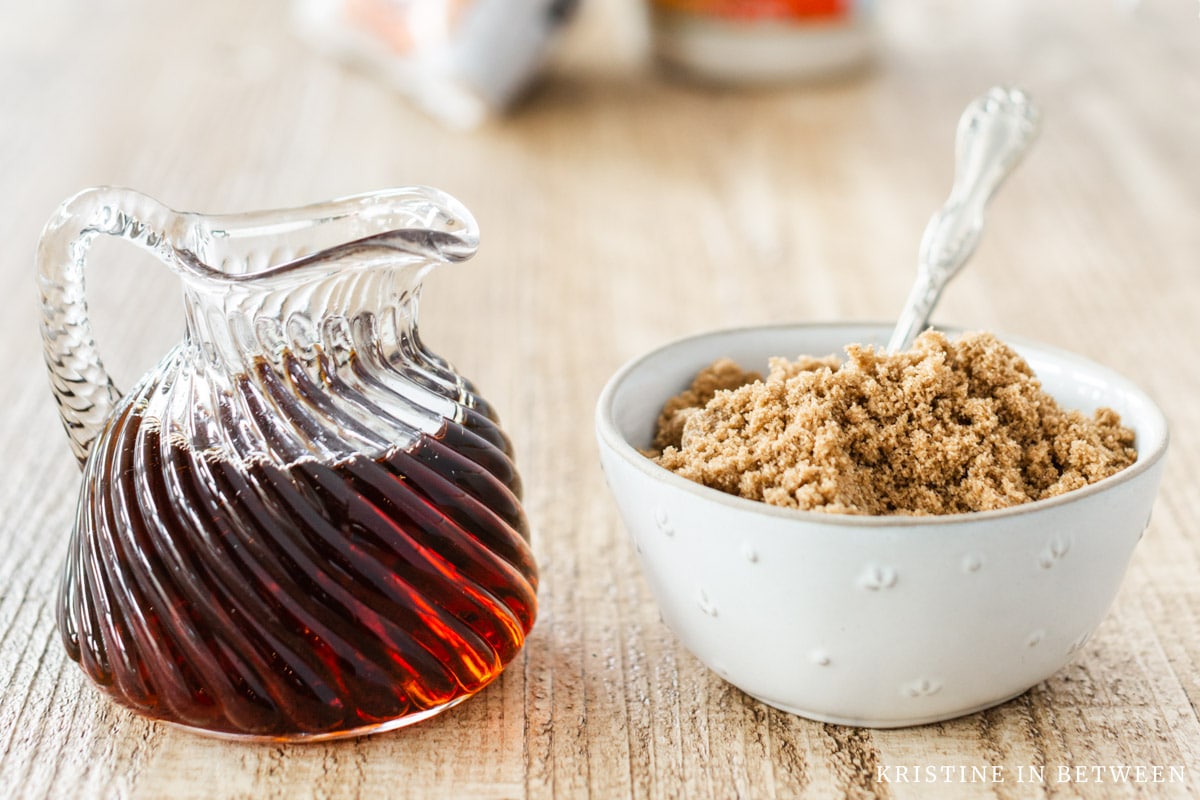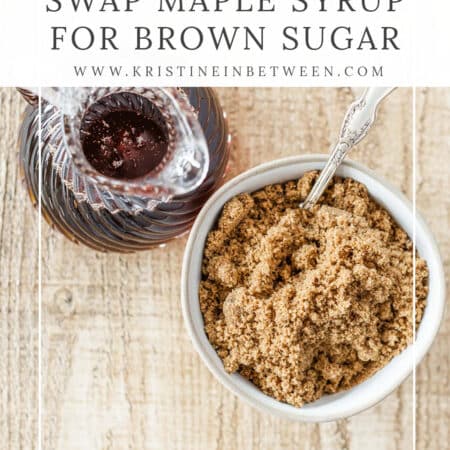This post contains affiliate links and we make a small commission for purchases made using these links.
I posted a recipe yesterday that got me thinking. It was adapted from a whole food recipe I’ve been making forever for blueberry pecan baked oatmeal. The original recipe is made with maple syrup, but I wanted the new recipe to be made with brown sugar.
So I worked out the conversion from maple syrup to brown sugar, and I thought it might be helpful for you too, since understanding ingredient substitutions can really up your cooking and baking game. So, let’s break this down.
Understanding the Differences
Maple Syrup: Derived from the sap of maple trees, maple syrup offers a rich flavor profile with hints of caramel and vanilla. Its viscosity can vary, depending on the grade, making it a versatile addition to both sweet and savory dishes.
Brown Sugar: A blend of white sugar and molasses, brown sugar has a moist texture and a distinct caramel-like taste. It’s available in light and dark varieties, each offering different depths of flavor to recipes.

Similarities and Compatibility
Despite their differences, maple syrup and brown sugar share key characteristics that make them interchangeable in many recipes:
- Sweetness: Both sweeteners provide sweetness to dishes, though with varying intensities. Their shared ability to sweeten recipes makes them good substitutes for one another (in most cases).
- Moisture Content: Maple syrup and brown sugar contribute moisture to recipes, influencing the texture and consistency of the final product. This aspect is particularly crucial in baking, where moisture levels can impact the outcome significantly.
- Caramel Flavor: Thanks to the caramelized sugars and molasses content, both sweeteners offer hints of caramel flavor. This shared profile makes them compatible in dishes that benefit from a touch of caramel sweetness.
Substitution Guidelines
Now that we’ve established the similarities between maple syrup and brown sugar, let’s talk about how to substitute one for the other effectively:
MAPLE SYRUP TO BROWN SUGAR:
When replacing maple syrup with brown sugar in a recipe, follow these simple guidelines:
- Ratio: For every cup of maple syrup, substitute 1 cup of packed brown sugar. Keep in mind that brown sugar is denser than maple syrup, so it’s essential to pack it firmly when measuring.
- Adjust Liquids: Since maple syrup is a liquid sweetener, you’ll need to add some liquid to compensate when substituting it with brown sugar. For every cup of maple syrup replaced, add 3 to 4 tablespoons of liquid (such as water, milk, or juice) to maintain the right moisture balance.
- Consider Flavor: While brown sugar shares similar caramel notes with maple syrup, it lacks the maple flavor. To enhance the flavor profile of your dish, consider adding a dash of vanilla extract or a pinch of cinnamon when substituting brown sugar for maple syrup.
BROWN SUGAR TO MAPLE SYRUP:
When substituting brown sugar with maple syrup, follow these guidelines:
- Ratio: For every cup of brown sugar, substitute ¾ cup of maple syrup. Since maple syrup is sweeter and more flavorful than brown sugar, you’ll need less of it to achieve the desired level of sweetness.
- Adjust Dry Ingredients: Since maple syrup adds moisture to recipes, you may need to reduce the amount of other wet ingredients or increase the quantity of dry ingredients slightly to maintain the proper consistency of your dish.
- Consider Texture: Keep in mind that maple syrup is a liquid sweetener, whereas brown sugar has a granular texture. Depending on the recipe, this difference in texture may affect the final outcome, particularly in baked goods. Be prepared for potential adjustments in baking time and temperature.
My Final Thoughts
By understanding the differences and similarities between maple syrup and brown sugar, as well as following these super easy substitution guidelines, you can seamlessly interchange these two sweeteners in your favorite recipes when needed (or better yet, when wanted).
Whether you’re whipping up a batch of cookies, glazing a roast, or sweetening your morning oatmeal, with a little know-how, the swap between maple syrup and brown sugar is both effortless and delicious.


This is just what I was looking for. Great explanation, Kristine!
Hi Melanie! Thank you so much, I’m glad you found it helpful. Happy baking! 🙂
In your Maple Syrup to Brown sugar conversion you say:
“Adjust Liquids: Since maple syrup is a liquid sweetener, you’ll need to adjust the liquids in your recipe accordingly. ”
Shouldn’t it be the opposite? Since brown sugar is denser, shouldn’t a bit more liquid be added rather than subtracted?
I’m trying this recipe right now and will comment on swapping the maple syrup for brown sugar.
Well, I can’t read, apparently. You don’t say to reduce liquids when using brown sugar, just “adjust” them! I might add a bit of honey for some more liquid. Thanks! Sorry for the booboo.
Hi Joanne! This is a great question, and some of it depends on how the recipe was written originally (which way the substitution is going) and what it is you’re baking (is it something you’re familiar with, and know what the batter/dough should look like?).
But to try to clarify—
Brown sugar is a dry ingredient that doesn’t contribute extra moisture to the recipe. Maple Syrup, being a liquid sweetener, does.
So, when you replace brown sugar with maple syrup, you need to reduce the other liquids in your recipe to maintain the correct consistency.
Since you’re adding a liquid (maple syrup) instead of a dry ingredient (brown sugar), reduce the other liquids in the recipe. The general guideline is to reduce the liquid by about 3 tablespoons to 1/4 cup for each cup of maple syrup used.
For example, if your recipe calls for 1 cup of brown sugar and 1 cup of milk, I’d start by using 1 cup of maple syrup instead of 1 cup of brown sugar and then reduce the milk to 3/4 cup to adjust for the additional liquid from the maple syrup.
Now, if you’re going the other way and your recipe calls for 1 cup of maple syrup and 1 cup of milk and you want to use brown sugar instead, I’d start by using 1 cup of brown sugar and 1 cup + 3 tablespoons of milk (or another liquid) to make up the difference in moisture lost by using brown sugar.
Does that make sense? I love writing these posts, but sometimes they are confusing.
…Oh, and it’s important to keep in mind that with any kind of substitution, there’s always some trial and error, and the outcome can vary recipe to recipe. I hope this helps and that your recipe turned out! 🙂
Hi, I have a concern about step 2 for replacing maple syrup with brown sugar. It says to reduce other liquids. Shouldn’t you be adding some liquid since you’re taking out the wet syrup?
Hi Jennifer! Thanks so much for your question and for catching that! You’re absolutely right—since maple syrup is a liquid and brown sugar is dry, you would need to **add** liquid, not reduce it. A good rule of thumb is to add about 3 to 4 tablespoons of liquid (like water or milk) per cup of maple syrup replaced. I’ll make sure to update the post to reflect that! Thanks again for your input, and happy baking! 😊